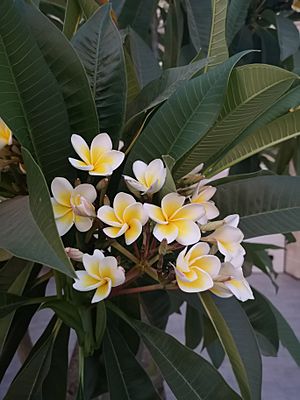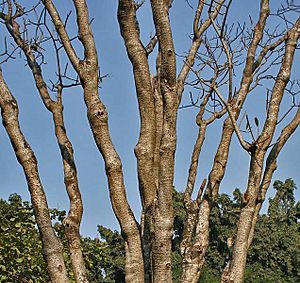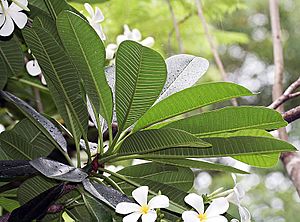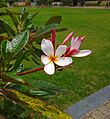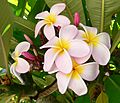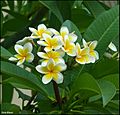Plumeria facts for kids
Quick facts for kids Plumeria |
|
|---|---|
 |
|
| Plumeria rubra | |
| Scientific classification |
|
| Kingdom: | Plantae |
| Clade: | Tracheophytes |
| Clade: | Angiosperms |
| Clade: | Eudicots |
| Clade: | Asterids |
| Order: | Gentianales |
| Family: | Apocynaceae |
| Subtribe: | Plumeriinae |
| Genus: | Plumeria L. |
| Species | |
|
See text |
|
| Synonyms | |
|
|
Plumeria (say "ploo-MEER-ee-uh"), also known as frangipani, is a group of flowering plants. Most kinds are deciduous shrubs or small trees, meaning they lose their leaves every year. These plants are originally from places like Mexico, Central America, the Caribbean, and parts of South America and Florida in the United States. But you can find them growing as beautiful ornamental plants in many warm parts of the world.
Contents
What's in a Name?
The name Plumeria honors a French botanist and monk named Charles Plumier from the 1600s. He traveled to the New World (the Americas) and wrote about many plants and animals he found. People often use "Plumeria" as a common name too, especially when talking about growing them.
The name "frangipani" comes from a story about a 16th-century Italian nobleman, the Marquis Frangipani. He supposedly made a perfume that smelled like these flowers. The common names for these plants can be different depending on the region, but "frangipani" is one of the most popular.
In places like eastern India and Bangladesh, plumeria is sometimes called golok chapa. This means the champaka flower that lives in the heavenly home of Sri Krishna, a Hindu god. The flower is seen as sacred there and is also known as gulancha and kath golap (which means "wood rose").
Kinds of Plumeria
The Plumeria group includes about a dozen accepted types, or species. Many of these species are found only in Cuba. Here are some of the well-known species:
- Plumeria alba - Found in Puerto Rico and the Lesser Antilles.
- Plumeria clusioides - Found in Cuba.
- Plumeria cubensis - Found in Cuba.
- Plumeria inodora - Found in Guyana, Colombia, and Venezuela.
- Plumeria obtusa - Found in the West Indies, southern Mexico, Belize, Guatemala, and Florida. It has also started growing naturally in China.
- Plumeria pudica - Found in Panama, Colombia, and Venezuela.
- Plumeria rubra - Found in Mexico, Central America, Colombia, and Venezuela. It grows naturally in many other places too, like China, the Himalayas, and the West Indies.
What Plumeria Looks Like
Plumeria branches are succulent, meaning they are thick and can store water. The trunk and branches have a milky sap inside. This sap can irritate your eyes and skin, so it's best not to touch it or get it in your mouth.
Leaves
Plumeria trees can be small or low shrubs. Their leaves grow in bunches at the ends of their branches. Different types of plumeria have different leaf shapes and ways their leaves are arranged. For example, the leaves of P. alba are narrow and crinkled. The leaves of P. pudica are long, shiny, and dark green. P. pudica is special because it often blooms all year round and keeps its leaves, unlike many other types.
Another type that keeps its leaves and flowers in winter is P. obtusa. Even though it's often called "Singapore," it actually comes from Colombia.
Flowers
Plumeria trees usually flower from early summer until fall. Their beautiful blossoms grow in clusters at the ends of the stems. Each flower has a tube-like base that opens into five rounded, waxy petals that overlap. These flowers come in many colors, including pink, red, white, yellow, orange, and pastel shades.
The flowers smell very strong, especially at night. Their scent can remind you of jasmine, citrus, or gardenia. But here's a cool trick: they don't actually make any nectar! Their strong scent fools sphinx moths into visiting them. The moths fly from flower to flower, looking for nectar, and in doing so, they accidentally move pollen around, helping the plant reproduce.
When insects or people help move pollen between different plumeria plants, it can create new kinds of plumeria. The seeds from these cross-pollinated flowers might grow into trees that look like the "mother" tree, or they might have completely new and unique flowers!
After flowering, the plant produces a fruit that splits into two parts, each containing winged seeds.
How Plumeria Grows
You can grow plumeria from seeds, or you can grow new plants from cuttings. To grow from a cutting, you take a piece of a stem in spring, let the cut end dry out for a bit, and then plant it in soil that drains water well. It's important that the soil isn't too wet, or the cutting might rot. Sometimes, people use a special powder called rooting hormone to help the cutting grow roots.
Plumeria cuttings can also be joined onto an already rooted plant, which is called grafting. There are many different types of plumeria that people have grown and registered, showing how popular and varied these plants are!
Plumeria in Culture

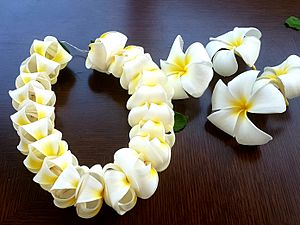
In Southeast Asia, the plumeria tree and its flowers are often seen as sacred. You can see carvings of plumeria trees with their unique flowers and branches on old temples like the Penataran temple in East Java and the Borobudur temple. These carvings were made long ago, even before Europeans explored the area.
In Mesoamerica (parts of Mexico and Central America), plumerias have been important for over 2,000 years. The Maya people linked plumerias to gods of life and fertility. The Aztec people used plumerias to show that someone was important or of high status. They even planted plumeria trees in the gardens of their nobles.
Today, plumerias grow naturally in many parts of South Asia and Southeast Asia. In some local stories, people believe these trees provide shelter for ghosts or spirits. They are also often found near temples in Hindu, Jain, and Buddhist cultures.
On many Pacific islands, like Tahiti, Fiji, Samoa, and Hawaii, people use Plumeria flowers to make beautiful leis (flower garlands). In Hawaii, the flower is called "melia." In modern Polynesian culture, women sometimes wear the flower behind their right ear if they are looking for a relationship, and behind their left ear if they are already in one.
Plumeria alba is the national flower of Laos, where it is known as champa or dok champa.
In Bengali culture (from India and Bangladesh), most white flowers, including plumeria (called chômpa or chãpa), are sometimes linked to funerals and death.
In the Philippines, Indonesia, and Malaysia, plumeria is also often connected with ghosts and cemeteries. People often plant them in burial grounds in these countries. However, they are also very common ornamental plants in homes, parks, and other open areas. Balinese Hindus use the flowers in their temple offerings. The strong smell of plumeria is also sometimes linked to the Kuntilanak, a spirit from Malaysian-Indonesian folk stories.
Indian incenses that smell like Plumeria rubra often have "champa" in their names. For example, nag champa is an incense that mixes the smell of plumeria and sandalwood. While plumeria is part of these incenses, the exact amount can change depending on the recipe. Many champa incenses also use other tree resins and flower smells to create a stronger, more plumeria-like scent.
In the Western Ghats of Karnataka, India, brides and grooms exchange garlands made of cream-colored plumeria flowers during weddings. Red plumeria flowers are not used for weddings there. Plumeria plants are found in most temples in these areas.
In Sri Lankan traditions, plumeria is connected to worship. An ancient painting from the fifth-century rock fortress Sigiriya shows a heavenly lady holding a five-petaled flower that looks just like a plumeria.
In Eastern Africa, frangipani flowers are sometimes mentioned in Swahili love poems.
Images for kids
-
Red frangipani found in Malaysia
-
White Plumeria, found at Andhra Pradesh
-
Flowering tree of Plumeria rubra decorating a garden in Tel Aviv, Israel
See also
 In Spanish: Plumeria para niños
In Spanish: Plumeria para niños


